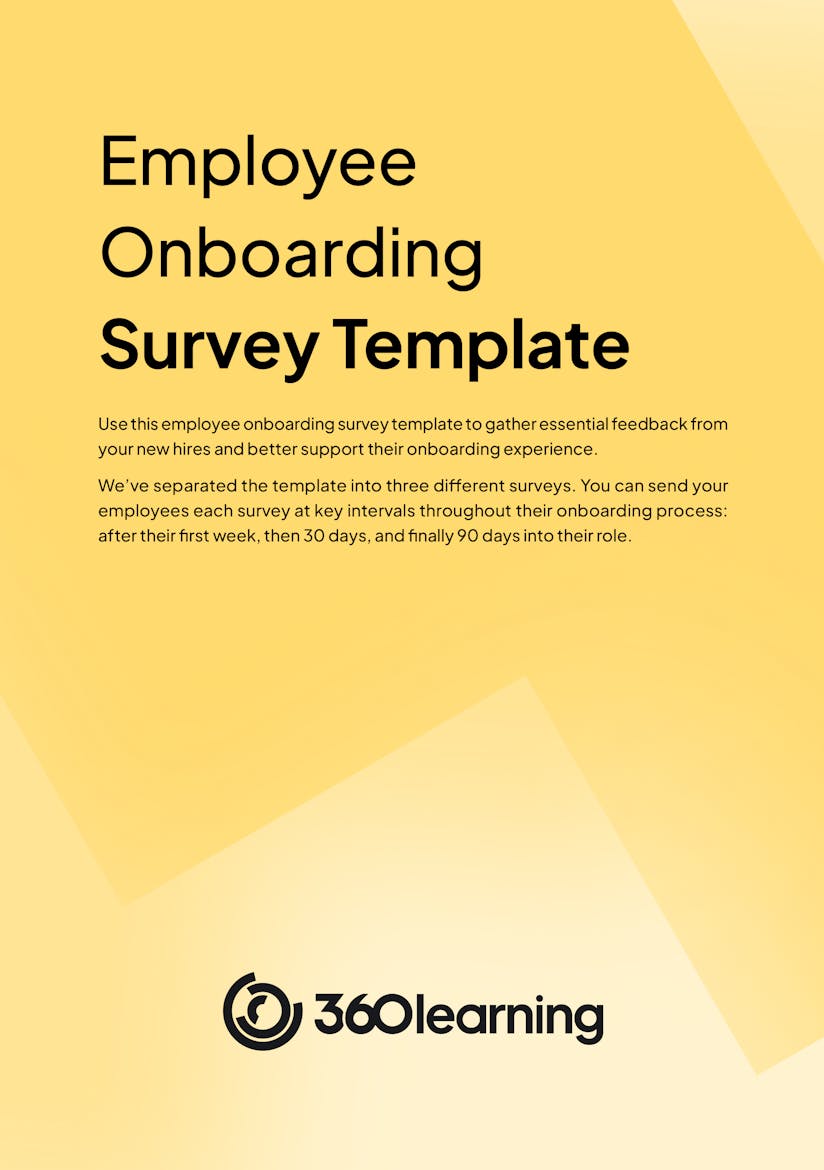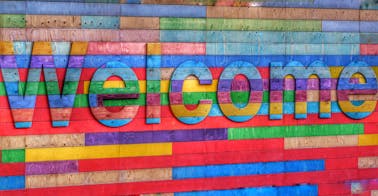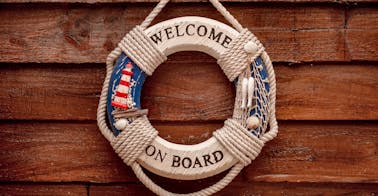
An effective onboarding program can increase your employee retention rate by 82% and boost your new-hire productivity by 72%. That’s a deal-maker for businesses who struggle with recruitment costs already.
Now, here’s the big problem. Most organizations don’t know how to do onboarding the right way - all they do is dump a huge pile of paperworks on new employees during their first week of work.
According to Gallup, only 12% of employees believe their companies provide the best onboarding experience. What about the remaining 88%? They are either providing the worst experience or just average.
In this article, we’ll share some proven ideas that you can use to spice up your onboarding program and give your new hires an unforgettable experience - enough to make you part of the 12% above.

Increase new hire retention by asking the right questions.
By providing your contact info, you agree to receive communications from 360Learning. You can opt-out at any time. For details, refer to our Privacy Policy.
1. Office scavenger hunt
Workplace integration is one of the biggest hurdles faced by employees in their first few weeks.
Let’s paint a scenario. When you first start in a new workplace, you may feel a bit lost and unsure of where to prioritize your attention. In fact, a report by Zippia shows that approximately 38% of new hires don’t know who they should meet in the company whenever they have questions or need a hand.
A create way to solve this is by creating an office scavenger hunt checklist.
Scavenger hunts are similar to the hide-and-seek games we played as kids. But the goal of this scavenger hunt is to enable new hires to familiarize themselves with the company resources, fellow team members and work colleagues, work environment, and even some business operations.
This in turn helps employees integrate into their new environment much quicker, enabling them to kick off productivity on a high note.
Here are two types of scavenger hunt for workplaces that you can consider implementing: Duo and Desk.
A Duo Scavenger Hunt involves pairing two employees up and giving them tasks to complete together. This is a fun hands-on way to collaborate and get to know one another. Here are some example tasks:
- Take a selfie with your duo to kickstart the scavenger hunt.
- Knock on the office door of every other department and take a picture with their team members. Do it in turn with your partner.
- Search around for a dozen puzzle segments in your new workplace to complete a puzzle. Turn them in to your admin or team leader once you and your partner have completed the task.
- Locate the founder’s statue and take pictures with your partner.
On the other hand, Desk Scavenger Hunt focuses on an individual employee instead of two. The aim here is to help your new hires get a good feel of their work environment and office space. You can consider these tasks in your checklist:
- Take a photo when your office clock makes a mathematical equation. For instance, 11:24 is 1+1+2=6.
- Find out the longest tenured employee on your team, besides your boss, and how many years they have been at the company.
- Take a picture with the newest and oldest team member.
- How many computers are in the office? See who can find the number first.

Example of a template you can use for new hire scavenger hunts.
2. Gamification
Gamification is the process of integrating game mechanics or features such as progress bars, points and reward systems, badges, and many others into non-gaming activities. This is a strategy applied by most brands using an online community platform to promote their services. But you can also integrate it with your onboarding program to create a more exciting experience.
To get things started, you can create a reward and points system that spans throughout the entire course of your onboarding program. This means your new hires get rewarded with points or even badges every time they complete an onboarding task. Once they've completed their onboarding, they can either use cumulative points to get rewards that you want to offer, like completion badges, cash prizes, experiences, or gifts.
Karl, author of The Gamification of Learning and Instructions, says that employers must “think of the engaging elements of why people play games - it's not just for the points - it's for the sense of engagement, immediate feedback, feeling of accomplishment, and success of striving against a challenge and overcoming it.”
Besides adding gamification to the onboarding process, you can also host some engaging team-building games to build rapport among your growing team and help new and tenured employees get to know each other better.
3. Provide a welcome kit
If office scavenger hunt and gamification aims to bring new hires close to other team mates, then a welcome kit focuses on bringing them closer to the company.
New employees usually feel like they’re working on a thin line for the first few days or weeks. Giving them a welcome kit serves as a good ground to throw away the “I am a stranger” belief and helps them integrate faster into the team.
When preparing a welcome kit, you need to do a preliminary research and personalize it for individual employee. First off, start with the basics of all welcome kits like a company handbook, as well as tech pack including a work laptop and other devices or gear they may use a lot for their roles.
Company swag is always fun, but even better when it's useful. Popular items to enable employees to proudly rep their new employer can be a company-branded tea or coffee mug, deluxe bag containing company-branded water bottles, custom embroidered hoodies, and caps.
4. Onboarding buddy
Imagine arriving at your new workplace on the first day, just to be left at your work desk alone and expected to figure everything out. Actually, most companies do this, and that’s why so many employees feel their current work culture is lacking.
Instead, you should assign an onboarding buddy to each of your new hires. Onboarding partners help new hires figure their way out in the office, introduce them to other colleagues, and help them assimilate to the company culture and work methodology. They also help new hires build stronger social bonds and feel more welcome in the company faster.
You can assign more than one buddy per new hire. In fact, top companies like Buffer use a minimum of three buddies to engage incoming employees, which allows for more flexibility and helps new hires make more connections right off the bat.
5. Employee feedback
Onboarding can go on for at least 3 months and last as long as a year. That’s long enough for a lot of interactions to take place between your new employee and the old guys. And it is these interactions that we want to capitalize on through a 360 feedback approach.
Technically, the 360 feedback approach involves an employee getting productive feedback from peers or fellow colleagues, supervisors, internal and external stakeholders, and any other unit of your company.
This in turn helps the employee to understand how well they are integrating with the company, their peers, team members, and the company’s culture within the short period they have been around.
Your new employee can also better understand their own weakness and strengths, things to work on, and how to be a better teammate. Moreover, knowing how others think or feel about them is one of the best ways to promote team building, an open culture, and a healthy workplace.
6. Team outings
Sometimes, keeping your onboarding program within the office alone can be boring. A way to fix this is by organizing team outings. These trips foster bong-building, organizational cohesion, enthusiastic working culture, and help your new employees feel included.
Things you need to consider include location, resources, and goals for the outing. To determine a location that suits the group, you can open it to voting among your new employee and others. You should also ask your employees what activities they would like to do during the onboarding trip to make sure you make the most out of this event.
7. Decorating and gifts greeting
Decorating and gifts greeting means welcoming your new employees on their first day with fanfare - right at the door. Starting a new job is an exciting new premise, so it's certainly worth celebrating! You can decorate their workspace to create a welcoming work ambiance and kick the energy off to a positive start on their first days. This also creates a fun and casual setting for colleagues to get to know and connect with their new teammates.
Onboarding should never be boring
It takes less than 10 seconds to leave a first impression. And it takes only a few interactions for employees to determine if they want to continue working with you. That's why using these strategies we've shared to develop a robust onboarding process is key to increasing your employee retention, productivity, and reducing recruitment costs.




